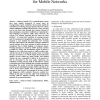Free Online Productivity Tools
i2Speak
i2Symbol
i2OCR
iTex2Img
iWeb2Print
iWeb2Shot
i2Type
iPdf2Split
iPdf2Merge
i2Bopomofo
i2Arabic
i2Style
i2Image
i2PDF
iLatex2Rtf
Sci2ools
93
Voted
JNW
2008
2008
Enhancement of Delivery of Warning Messages for Mobile Networks
Vehicle-to-vehicle (V2V) communication systems have been studied extensively in recent years by transportation experts worldwide. Such systems enable the transmission of warning messages (alarms) between vehicles without additional roadside infrastructure. Thus, messages can be sent faster than through base stations. Because of these advantages, researchers worldwide are exploring how this technology can improve traffic safety. However, the various V2V schemes proposed thus far share the same problem (1) unnecessary repetition of warning messages and (2) transmission to inapplicable respondents. This study proposes a new method for delivering V2V warning messages which reduces the redundant messages common in current schemes. Here, three schemes to deliver alarms are considered. One is blind flooding to broadcast alarms. Warning messages are routed by AODV protocol. Another is called Two Lanes. The broadcasting region of alarms is limited in two traffic lanes nearby a traffic accident ...
Related Content
| Added | 13 Dec 2010 |
| Updated | 13 Dec 2010 |
| Type | Journal |
| Year | 2008 |
| Where | JNW |
| Authors | Chia-Sheng Tsai, Wun-Kai Du |
Comments (0)

